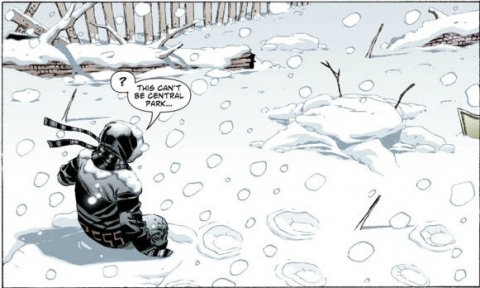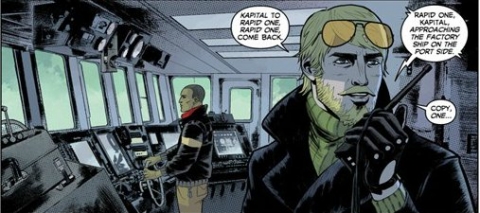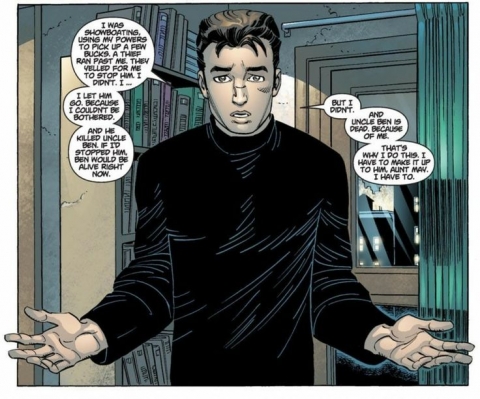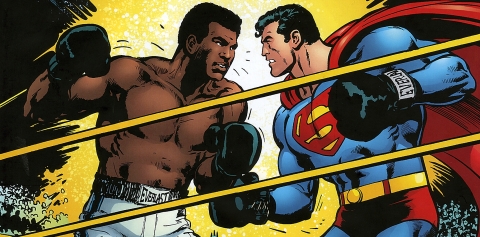52 weeks. 52 different writers. 2 trade paperbacks or hardcovers a week. Each week I’ll take a look at a different writer and read two different collected editions from within that person’s repertoire to help in the examination of their work.
Brian Wood is a creator who has loomed within comics since the late 90’s, truly breaking out as a creator in the early to mid 2000’s. A writer, artist, and graphic designer, Wood worked a day job with the popular video game publisher, Rockstar Games, before leaving the job to create comics full-time. His first truly successful comic was Demo, working with artist Becky Cloonan to create a unique series for readers. In 2006 Wood signed an exclusive contract with DC and Vertigo comics, which gave way to today’s book, the critically acclaimed series DMZ.
DMZ Volume 1: On The Ground
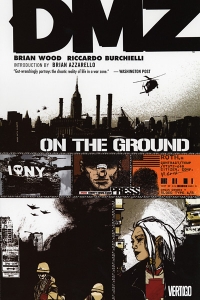 America is waging a war on many fronts, becoming so distracted by its actions overseas that it misses what’s happening in its own backyard. The second American Civil War breaks out in violent fashion with Manhattan as the ground zero for this country altering event. America stands splintered with Manhattan as the war zone for the battle between the United States of America and the freshly minted Free States of America. From the outside looking in, the USA spins a tale of how crippled and decrepit the Free States and Manhattan appear, using media to cloud the minds of those safely outside of the region now known as the DMZ. Five years into this war, photo journalist Matty Roth gets the opportunity of a lifetime, interning for a news station that is about to send in a famous battlefield journalist. Everything changes when Matty ends up stranded in the DMZ, choosing to take on the task of showing the rest of the world what the DMZ is truly like by himself. Along the way he is enlightened to the surprisingly diverse life styles of everyone living and surviving within the DMZ, radically changing not only how the world see Free States but how Matty sees himself as well.
America is waging a war on many fronts, becoming so distracted by its actions overseas that it misses what’s happening in its own backyard. The second American Civil War breaks out in violent fashion with Manhattan as the ground zero for this country altering event. America stands splintered with Manhattan as the war zone for the battle between the United States of America and the freshly minted Free States of America. From the outside looking in, the USA spins a tale of how crippled and decrepit the Free States and Manhattan appear, using media to cloud the minds of those safely outside of the region now known as the DMZ. Five years into this war, photo journalist Matty Roth gets the opportunity of a lifetime, interning for a news station that is about to send in a famous battlefield journalist. Everything changes when Matty ends up stranded in the DMZ, choosing to take on the task of showing the rest of the world what the DMZ is truly like by himself. Along the way he is enlightened to the surprisingly diverse life styles of everyone living and surviving within the DMZ, radically changing not only how the world see Free States but how Matty sees himself as well.
You have to stop whatever you’re doing and go read DMZ right now. I genuinely feel as though I could end the article after that sentence and feel satisfied with my work on this piece. I’ll still go into great detail to tell you all about this story, but be forewarned, I’m going to lob praise all over this series for how utterly brilliant it is. After reading this first volume (I’m ashamed to admit for the first time ever) I nearly altered my year-long plan for this challenge so that I could just read the other eleven volumes of this series with haste. There’s something to be said about the consistent, quality work that Vertigo seems to produce, allowing creators to do their absolute best with whatever story they want to tell. Brian Wood’s “DMZ” is no exception, as Wood crafts one of the best first volumes of a series I’ve ever read.
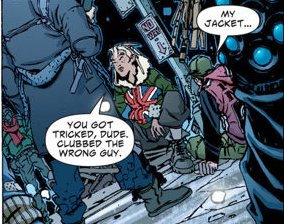 Let’s start with the absolute best part of the series and work our way down. Brian Wood is a man who knows how to world build. The environments that he gleefully just throws readers into are always so disgustingly immersive that you can basically smell and feel the world at the tip of your fingers on the page. In just the first issue alone of this collection you’re thrust into this entirely new world that sucks you in and shakes you. At first you’re shown a decomposing Manhattan, a city that seems on the verge of collapse but as the story progresses you realize that Manhattan (now the DMZ) still has a functioning society holding it all together. It’s almost reminiscent of a favela you’d see in Brazil, looking like a gross back alley world that still has incredible amounts of culture packed into the massive community surviving in a tiny place. Wood shows us how in the five years since the war has started, neighbourhoods and blocks have become like the new borders within the Free States’ territories. Each new region of the Free States has its own set of rules that must be followed, with someone who doesn’t know the DMZ well easily stumbling into enemy territory without even being aware. Wood could write an entire series based off of just the first region you encounter as a reader but quickly shows he has far more interest in showing you as much of the DMZ as possible in the short time he has with you for this first volume, evening going as far as using the final issue in this collection as a whirlwind tour of where Matty has been as well as where he may be going. With this first volume alone, Brian Wood easily makes a claim for being the pound-for-pound world building king of comics. Go read this first volume and good luck trying to argue that fact.
Let’s start with the absolute best part of the series and work our way down. Brian Wood is a man who knows how to world build. The environments that he gleefully just throws readers into are always so disgustingly immersive that you can basically smell and feel the world at the tip of your fingers on the page. In just the first issue alone of this collection you’re thrust into this entirely new world that sucks you in and shakes you. At first you’re shown a decomposing Manhattan, a city that seems on the verge of collapse but as the story progresses you realize that Manhattan (now the DMZ) still has a functioning society holding it all together. It’s almost reminiscent of a favela you’d see in Brazil, looking like a gross back alley world that still has incredible amounts of culture packed into the massive community surviving in a tiny place. Wood shows us how in the five years since the war has started, neighbourhoods and blocks have become like the new borders within the Free States’ territories. Each new region of the Free States has its own set of rules that must be followed, with someone who doesn’t know the DMZ well easily stumbling into enemy territory without even being aware. Wood could write an entire series based off of just the first region you encounter as a reader but quickly shows he has far more interest in showing you as much of the DMZ as possible in the short time he has with you for this first volume, evening going as far as using the final issue in this collection as a whirlwind tour of where Matty has been as well as where he may be going. With this first volume alone, Brian Wood easily makes a claim for being the pound-for-pound world building king of comics. Go read this first volume and good luck trying to argue that fact.
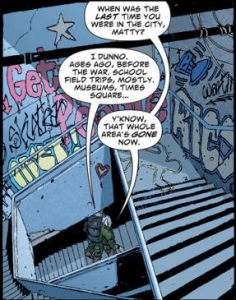 Another brilliant step that Wood takes with DMZ is how he frames his characters, specifically the lead in Matty Roth. Roth is an intern photo journalist who gets the opportunity of a lifetime to experience this changed world that is the DMZ. He’s a man who comes from privileges in the sense that he is living outside of the horrible, war-torn conditions that the people inside of the DMZ have to deal with each and every day. In that regard, a lot of people who read this story should immediately relate to Matty as he’s getting thrown into this whole new environment at the exact same time the reader is, learning the rules and limitations as he goes along trying to survive. Matty is a character who doesn’t so much evolve as he does adapt, adjusting how he lives to the conditions around him. Wood does take the time to peel back and show some other characters important to the story but in this first volume they’re present so that they can establish a connection to Matty as opposed to actually having them effect the story dramatically. It’s all about setting up a future for Matty within the DMZ, something that Wood does easily with this first volume.
Another brilliant step that Wood takes with DMZ is how he frames his characters, specifically the lead in Matty Roth. Roth is an intern photo journalist who gets the opportunity of a lifetime to experience this changed world that is the DMZ. He’s a man who comes from privileges in the sense that he is living outside of the horrible, war-torn conditions that the people inside of the DMZ have to deal with each and every day. In that regard, a lot of people who read this story should immediately relate to Matty as he’s getting thrown into this whole new environment at the exact same time the reader is, learning the rules and limitations as he goes along trying to survive. Matty is a character who doesn’t so much evolve as he does adapt, adjusting how he lives to the conditions around him. Wood does take the time to peel back and show some other characters important to the story but in this first volume they’re present so that they can establish a connection to Matty as opposed to actually having them effect the story dramatically. It’s all about setting up a future for Matty within the DMZ, something that Wood does easily with this first volume.
In a post 9/11 world, this series feels like it naturally carries so much more weight than just being another slanderous, politically motivated comic. Wood shows the reader that life still goes on after such a dramatic change, going to great lengths to build a series that isn’t reliant on cheap tricks and shock value. The shock value comes from how real everything feels, chilling you to the bone with how socially aware and politically sound every bit of the story comes off as. DMZ in a nutshell is raw, intelligent, and startling in its bold approach.
Collects: DMZ #1-6.
Best Character: Matty Roth.
Best Line Of Dialogue/Caption: “This couple, on opposite sides of a civil war, literally looking down the barrels of their guns at each other, writing love notes. Both of them traitors. Neither of them care.” – Matty Roth.
Best Scene/Moment: Any scene where you learn more about the DMZ – every single issue.
Best Issue: Issue 1. Issue one is easily the best issue of an incredible solid collection of stories. The tense, futile nature of this first issue will have your pulse pounding as everything descends into anarchy quite quickly for Matty Roth. It’s fast paced, on the nose, powerful, and stunning all at the same time. This issue is an impressive opening note from Brian Wood, one that resonates throughout the remainder of this collection.
Why You Should Read It: Read this because it’s a simply brilliant series. DMZ is a master class in world building, as within just a few short pages Brian Wood shows you everything you think you need to know about this setting before drastically changing it with the simple act of having a character walk one block too far down the street. The rules, the characters, the setting, it’s all not only breathtaking, but stark, grim, depressing, and shockingly eye-opening. This might not be the type of comic we as humans deserve, but it’s definitely one we all need to read.
The Massive Volume 1: Black Pacific
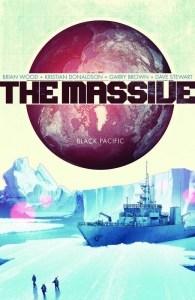 Brian Wood is a man who has worked for plenty of publishers over his career. Ranging for Marvel to DC, Image to Dark Horse, and even a few smaller ones in between. Wood is perhaps at his best though when he is free to write whatever type of comic he wants. He manages to be one of the most fascinating and engaging world builders in comics today, using his stories to show us where the world could be heading or even showing us how life would look life following the end of the world. Regardless of what type of story he’s trying to tell, one can always rest assured that Wood will create the richest world possible for the reader to enjoy.
Brian Wood is a man who has worked for plenty of publishers over his career. Ranging for Marvel to DC, Image to Dark Horse, and even a few smaller ones in between. Wood is perhaps at his best though when he is free to write whatever type of comic he wants. He manages to be one of the most fascinating and engaging world builders in comics today, using his stories to show us where the world could be heading or even showing us how life would look life following the end of the world. Regardless of what type of story he’s trying to tell, one can always rest assured that Wood will create the richest world possible for the reader to enjoy.
In a post-Crash world, where a series of natural disasters have uprooted the social, economic, political, and geological layouts of the world, an environmentalist group, Ninth Wave, travels by sea to the ends of the Earth. Traveling via a ship, The Kapital, Captain Callum Israel searches for their missing sister ship, The Massive. The crew of the Kapital search for fresh water, food, and fuel along the way while contending with mercenaries, pirates, and even environmental hazards that threaten their pacifist ways. Callum, a former member of the Blackbell PMC, butts heads with other members of the Kapital over his decision to use non-violent means to survive in a world where the rules have dramatically changed. With the help of Mags, a fellow former mercenary, and Mary, a mysterious yet enigmatic women, Callum seeks to push Ninth Wave’s ideals out towards the rest of the crippled world in the hopes of making a true difference in light of these natural disasters.
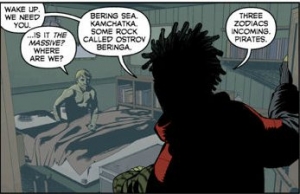 The Massive by Brian Wood is what I would refer to as a grounded Sci-Fi/disaster epic, being a somewhat more believable version of the film “The Day After Tomorrow” (and considerably more enjoyable for what that’s worth). This series is just another example of why Brian Wood is hands down one of the best world builders in all of comics, much like I stated in my previous post about him just the other day. With this story we get a reality we can see coming, with the increase of natural disasters occurring around the world it’s hard to not feel that a story like this one is simply foreshadowing our unfortunate future. A bleak outlook, I’m sure, but one that still feels ever-present and honest especially after reading this collection.
The Massive by Brian Wood is what I would refer to as a grounded Sci-Fi/disaster epic, being a somewhat more believable version of the film “The Day After Tomorrow” (and considerably more enjoyable for what that’s worth). This series is just another example of why Brian Wood is hands down one of the best world builders in all of comics, much like I stated in my previous post about him just the other day. With this story we get a reality we can see coming, with the increase of natural disasters occurring around the world it’s hard to not feel that a story like this one is simply foreshadowing our unfortunate future. A bleak outlook, I’m sure, but one that still feels ever-present and honest especially after reading this collection.
Our world appears to be on the brink of an ecological collapse when it comes to The Massive, as we see the ice in Antarctica breaking apart for good or places like Hong Kong completely changing due to massive flooding. How humans interact with any land mass, body of water or natural part of the Earth has dramatically changed in light of a sudden wave of natural disasters that completely change the state and function of many facets of our lives. The Massive shows you what happens after civilization collapses, showing how people survive in the face of tragedy. Where Wood really strikes gold with this story isn’t in how he approaches his characters, it’s in how he gives the readers glimpses of what happened while showing them the new rules of life that are instituted as a result. All the way throughout this story, Wood will cut between the present and future, showing us the conflicts our lead characters face while cutting in scenes depicting what type of disaster struck places like New York, Hong Kong, Somalia, etc., giving you a genuinely chilling fictional history. These incredibly brief glimpses are typically in one panel with one to two captions describing what happened but they feel vivid to the reader, with the sharpness of Wood’s words being enough to impart a feeling of tragedy upon them.
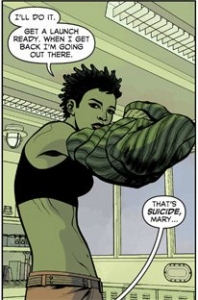 The main focus of the series isn’t what happened to the world but what’s happening within this changed world now, while Ninth Wave, aboard the Kapital, traverse it in search of its missing sister ship, The Massive. The reader follows Callum Israel, a middle-aged former mercenary turned pacifist, who founded Ninth Wave. On top of our glimpses into the disasters that changed the world, we get glimpses into the past of Callum and his fellow crew members, enlightening the reader to what makes these characters tick. You watch as Callum goes from a focused mercenary to being a man who becomes sickened by that line of work. Wood shows the readers a logical explanation as to why Callum is the man he is today and does it with seeming ease. You get so immersed into Callum and his team as humans that you actually start to forget the whole series focuses on finding the missing Massive, which is nothing if not a good thing. This results in plenty of the stories being broken down into smaller arcs, lasting sometimes just a single issue as you see the struggles that any character faces on just a single day. Wood manages to find plenty of thrilling conflicts for the characters to contend with whilst they search for their missing sister ship.
The main focus of the series isn’t what happened to the world but what’s happening within this changed world now, while Ninth Wave, aboard the Kapital, traverse it in search of its missing sister ship, The Massive. The reader follows Callum Israel, a middle-aged former mercenary turned pacifist, who founded Ninth Wave. On top of our glimpses into the disasters that changed the world, we get glimpses into the past of Callum and his fellow crew members, enlightening the reader to what makes these characters tick. You watch as Callum goes from a focused mercenary to being a man who becomes sickened by that line of work. Wood shows the readers a logical explanation as to why Callum is the man he is today and does it with seeming ease. You get so immersed into Callum and his team as humans that you actually start to forget the whole series focuses on finding the missing Massive, which is nothing if not a good thing. This results in plenty of the stories being broken down into smaller arcs, lasting sometimes just a single issue as you see the struggles that any character faces on just a single day. Wood manages to find plenty of thrilling conflicts for the characters to contend with whilst they search for their missing sister ship.
In a series like the Massive, that finds strength in examining the new rules of a changed world, it should be no surprise that Wood and the readers get to visit a wide array of different settings. Each issue is essentially a new adventure, either continuing the present day narrative thread of trying to find The Massive or giving you a glimpse of a past adventure Callum and the crew have experienced. In one issue we’ll see a bit of Somalia before the world fell apart, then the story will cut to the crew discovering a flooded Hong Kong and how that changed the economy of the remaining parts of that city. A few issues later, the crew heads to Antarctica to get ice to melt for water, spending the entire issue in the snowy terrain, but a few issues before that the crew was in a sunny and warm setting. There are so many different areas that are explored in this volume that there’s no way for me to even remember them all as I write this article. It’s easier to just say that you get a great range of different settings across this entire first volume, never feeling as though you’re overloaded with all the new sights you see but still enthralled enough that you want to see even more.
Collects: The Massive #1-6, material from Dark Horse Presents #8-10.
Best Character: Callum Israel.
Best Line Of Dialogue/Caption: “I’ve been on so many sides of a situation like this. The fact that I’m here again is almost comical. How did we sleep at night, you and I, working for Blackbell?” – Callum Israel.
Best Scene/Moment: Mary shows off some of her skills – Issue 5.
Best Issue: Issue 5. Issue five is an interesting one as it focuses entirely on Mary, a mysterious women on the Kapital, and Ryan, a self-obsessed American female, as they travel to Antarctica in hopes of getting pieces of ice for fresh water on the Kapital. This is an issue that not only has stunning art all the way through but is rather tense in its approach. It presents more questions than answers but also shows that there aren’t many rules in this new world.
Why You Should Read It: This is a story about the apocalypse that actually seems believable. The world ends and keeps on living, showing how characters survive in this changed land. I can say it one hundred times over that Brian Wood is simply an amazing world builder and he does it again with this series. The plotting can be a bit obtuse at times but what you get are some truly enjoyable stories detailing the life and times of the members of Ninth Wave. It’s rich, rewarding, and above all else, surprisingly effective in its approach. This is a story about how the greatest danger to Earth is Earth itself and it’d be a damn shame if you missed it.

